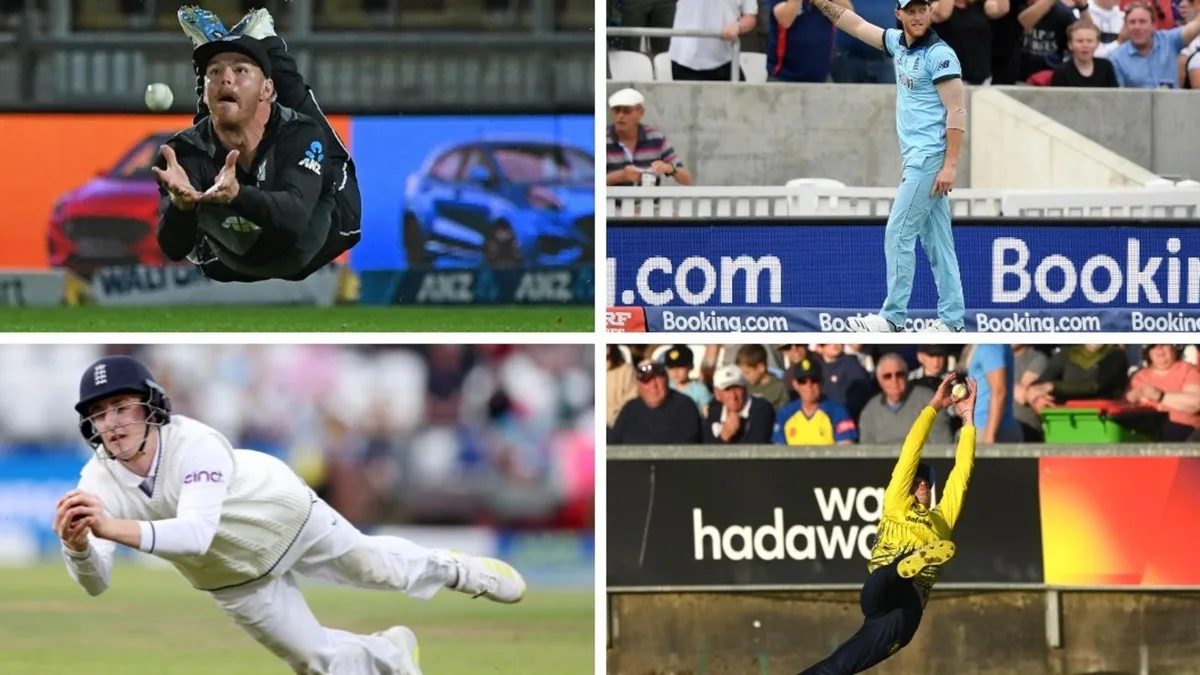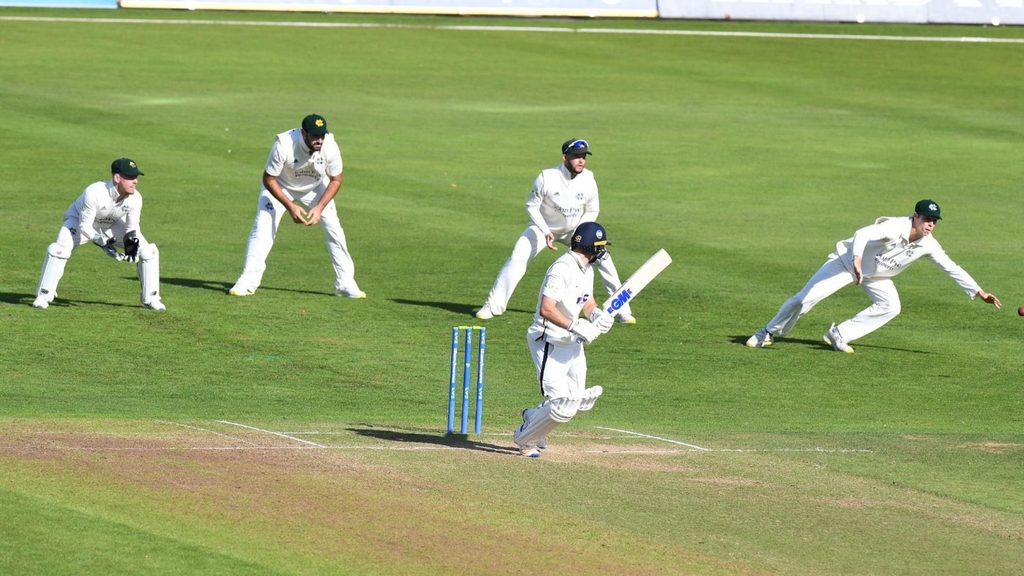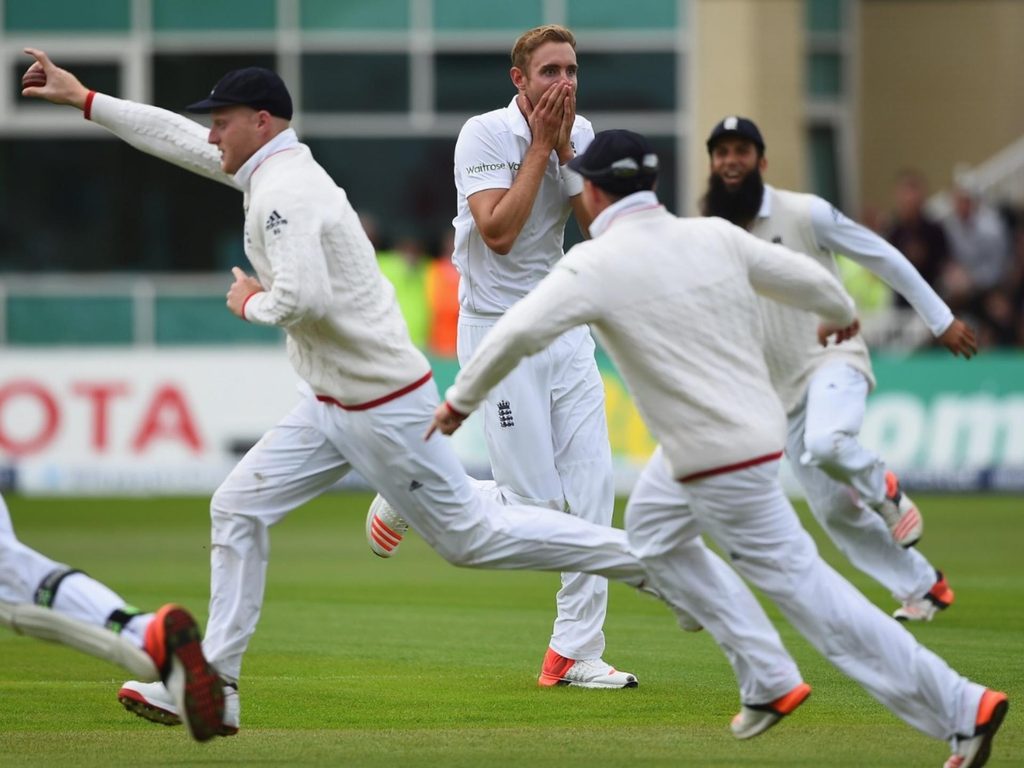
Few moments in cricket can produce the intense emotions which the greatest of catches summon. Katya Witney speaks to those behind the most spectacular efforts to unpick the anatomy of a great catch.
Blink and you’ll miss it. A dive through the air, one arm outstretched desperately trying to cover as much ground as possible in the split second before the ball hits the turf. Then suddenly, a body tumbling on the ground, rolling over with the immense momentum generated in little more than a heartbeat. But, as the tumbling stops, an arm emerges holding the ball triumphantly aloft before its holder is mobbed by ecstatic teammates.
Catches which are now seen regularly in the field were deemed impossible not so long ago. What was considered exceptional in the past is now deemed standard, and what was unfeasible is now achievable for the elite few. Previously, fielding was largely a barely practiced chore. Now players see it as a chance to increase their value in the franchise market, and coaches view it as an opportunity to influence the game.
There’s also an added incentive. Viral moments clipped up and shared on social media of bodies contorted, flying through the air and plucking a 2.8 inch dot out of the sky are a new outlet for the game’s greatest entertainers. These moments draw the kind of visceral reaction a searing yorker demolishing the stumps or a six sailing over the rope can’t. There’s anticipation as the ball is in the air, as viewers and fans work out as one if it will land safe or be intercepted, whether catching it is even a possibility. The higher the stakes, and the more impossible the catch seems, the more intense the release is.
As these flashes of brilliance have become more frequent, proliferated by the surge in batting power and professionalism, the shift in preparation can’t be the only explanation. Among those capable of producing these moments, there’s commonality in mindset which sets them apart. But, as well as these controllable variables, there’s an unpredictability that can’t be accounted for by mental or physical preparation. There will always be an element of luck which separates catches which stick and are remembered as all time greats, and those that spill and are forgotten.
*****
The ball flies off the thick edge of Jake Libby’s bat. As he follows its path, for a brief moment he might be thinking he’s got away with it. But, as the ball soars wide of the cordon, Calvin Harrison leaps into action. Springing to his right from his position at third slip, he sticks his arm out as the ball reaches him at thigh height. In the half-second following the ball leaving Libby’s bat, Harrison doesn’t take his eyes off it. He watches it all the way into the tips of his fingers, curling them to close it in his palm. Ending up fully horizontal before falling to the ground with a barrel roll, without missing a beat he gets back to his feet and gleefully hurls the ball into the air.
“I’m always expecting the ball to come to me,” says Harrison. “Fielding is something I’ve always held as important as batting and bowling. The importance of it was drummed into me from when I first started playing cricket by my old man. I’ve always tried to focus on it just as much as my other disciplines.”
The catch to dismiss Libby was one of a number from Harrison’s highlights reel this summer. There was also a one-handed stunner off his own bowling, several more at that slip which would’ve troubled a gully, and a leaping one-handed effort where he jumped high enough to be out of camera shot. He currently has the second-most catches in Division One of the County Championship, and the highest catch-per-innings ratio of anyone who’s played more than two matches.

Behind it all is a relentless mentality of expectation, often sustained throughout eight hour days in the field, and an uncompromising approach to preparation.
“There’s no secret formula,” he says. “It’s just about how much volume you can get in to make it as natural as possible. I don’t think there’s a right or a wrong way to do it as long as you get into that position early and watch the ball. It can be tough to develop someone’s anticipation of the ball, but you can always change someone’s focus to anticipate the catch coming towards you.
“I take any decision-making out of the equation. If you assume the ball is coming to you then you can react in whatever way to the ball in your area. Your reaction will then be based on how much you’ve practiced, because the movements you do will be whatever’s natural for you. If you train them, reaction catches feel very natural because when you get a quick one like that, you’re more likely to stay in a strong position.
“The biggest challenge is keeping focussed all day, especially if there’s a big partnership. It’s easy when wickets are falling and you always feel in the game as a fielder. But the ability, in the 80th or 90th over of the day, especially if there’s not been a wicket for a while, to switch off in between balls and then switch back on and expect that ball to come just as it would in the first over of the day is tough.”
That challenge of maintaining focus is at its most intense in the slip cordon, where the majority of catches are taken in the red ball format. Balls fly behind the wicket off bowlers sending them down in the late eighties, with no warning until it’s nearly on top of you. The difference between the catch going down and getting that breakthrough can be in a tenth of a second. But Harrison rejects that that minuscule difference comes down to anything other than preparation.
“There’s no easy catch in the slips,” he says. “You do get some that come slower than others but you can definitely drop catches that look very easy but that are actually very difficult. For example, when the ball wobbles - which you don’t really see on camera - they always come a little bit quicker than you think or than it looks. I’ve definitely taken a few that have felt like they’ve absolutely flown, taken it with one hand and then you look at it on the camera and it doesn’t quite look the same.
“If you’ve done all the work and it holds, whether it looks like a fluke or not is irrelevant. Even if you don’t see it, and you just react and manage to catch it, more often than not you move in the way you’ve practiced so it’s never really a fluke.”
Also read: Which captains would have topped the all-time World Test Championship tables?
*****
The ball comes straight off the face of Marnus Labuschagne’s bat. Angled up, it shoots through the air, seemingly set to race down to the deep point boundary for four. As the camera pans away from Labuschagne to follow the ball’s progress to the fence, suddenly the view changes. Glenn Phillips flies, Superman-style, perfectly horizontal, onto the screen. Before the camera properly registers him, Phillips hits the ground. He is up again a second later, letting out a wide-mouthed roar. It isn’t until he throws it away again that most of his teammates realise he’s caught the ball.
“It’s a strange one to talk about because you don’t really remember anything,” says Phillips. “Everything happens so quickly and you’re in a position which is really close. You’ve caught hundreds and hundreds of balls and it’s all of those things coming together in one perfect moment for the right length of the ball to be away from me to be fully outstretched, give everything in the dive and for it to stick. It’s a combination of elements that come together in a blur of one rapid moment.”

Unlike Harrison, Phillips is forthright on the element of luck in catches like these.
“I’m going to say 50/50,” he says. “There’s definitely 50 percent luck. If your hand is in slightly the wrong position, it goes down and it becomes a ‘What if he could have got there’ moment. So there’s definitely a lot of luck, but it also comes down to a lot of training.
“Gary Player from the golfing world said, ‘The harder I work, the luckier I get’, and that definitely rings true for certain aspects. When it comes to basic catches, I definitely think the more you train the less you have to worry about them and the easier they become. But when it comes to reaction catches, a lot of it comes down to luck.”
Phillips has earned a reputation as one of the best fielders in the world. While that in part comes from his wicketkeeping background, it also comes from an endless energy and, bluntly, a flare for showmanship.
“I’m an entertainer at heart,” he says. “It’s part of the reason I play the game, knowing that if I’ve done something special it’s going to be seen and people love it. It really gets me going and gets people up, the guys in the field as well. That’s definitely a huge piece of it, knowing that if I do something special then other people are going to see it, not just me.”
Phillips’ showreel isn’t just limited to his reaction speed inside the ring. Against the West Indies in 2020, he plucked the ball out of the air just before it went over the rope, running backwards and diving with both hands.
Also read: Glenn Phillips: I’ve been given a genetically prime body, it's my responsibility to use it well
Part of Phillips’ ability to pull off jaw-dropping catches in the deep comes from how high he can jump, despite being one of the shorter cricketers on the men’s circuit, standing at 5ft 7in. Last month, while representing Welsh Fire in The Hundred, in an attempt to catch a powerful pull from Jamie Overton on the boundary edge, he jumped almost as high as his head height from a standing start. While he was ultimately unsuccessful in stopping the ball going for six, how high he was able to jump demonstrated the bedrock of skill which underpins his extraordinary natural abilities.
“I probably knew I was getting nowhere near it,” Phillips says. “But I thought it might look cool if I got kind of close. I did a lot of athletics growing up and did some long jump, so the hops have always been in my system, and I think it comes from that element of entertainment as well.”
The baseline is that most fielders cannot do what Phillips does. As much as he, Harrison and others can get the rewards of viral moments and cheers from the crowd, no matter how many catches others take in training, those moments simply aren’t achievable.
“I’ve got no issue with people not being able to pull stuff off, I’ve got an issue with people not putting in 100 percent,” says Phillips. “That’s my only thing. If you put in 100 percent and you don’t get there, or you drop it, you’ve done the work. I have no qualms. I am more than happy to applaud someone who put in the effort.
“Not everyone is going to be able to run fast, not everyone is going to be able to jump high, but if they’re doing what they can do to the best of their ability for the team, that’s all that matters to me.
“I’m a big believer in the no-excuses mindset. I don’t want to be on the field if I don’t feel like I’ve done what I need to do in training. I feel like I’m letting myself down and I’m letting the team down. You can always take more catches in training. The more you catch, the better you’re going to be, the more comfortable you’re going to be under different situations… If I drop one in the game, it’s not for lack of work put in behind the scenes.”
*****
“Oh what a catch,” shouts David Lloyd down the microphone. “Ben Stokes, they’re tumbling all over the place. Australia are five down!”
As those iconic words blare out through TV sets up and down the land, the first air of what will become a soundtrack to rain-delay footage for years to come, then-England fielding coach Chris Taylor is standing on the team balcony at Trent Bridge, grinning. Stuart Broad is on his way to winning the Ashes in a session. Stokes has just provided the spell’s defining image. And Taylor has seen all his hard work pay off in spectacular fashion.

“He was doing a load of those catches during practice,” says Taylor now. “At the time he was, not moaning, but thinking that he was doing all the work but what’s the point if he’ll never get the chance. But that gets the message home that you do all the work for that reason, because you can pull off a catch like that. It didn’t necessarily impact the game because we were flying at the time. But it was a nice moment from working on something on the training ground to seeing it work live.”
Taylor was one of the early pioneers of elite fielding in the English domestic game. He gained a reputation on the circuit during his playing career as a gun fielder, and went straight into a fielding coaching role after retiring in 2011.
“I don’t ever recall, certainly as a player, any coach going into detail about catching technique,” says Taylor. “If you were involved with a coach that couldn’t see the value in fielding, there was a chance you didn’t do as much fielding in practice as other teams.
“As a fielding coach, I started to think more about technique and how to improve it when it came down to fielding. I became creative with practice, trying to drill styles and different angles. I very much work on the premise that if I can replicate a chance a player might get in the field then, by definition, that player has a better chance of taking any catch that might come to him.
“I spent a lot of time thinking about angles and the way the ball came off the bat, as well as speed. From a coaching point of view, you have to have your conscience clear that when a player goes over the line, there’s nothing that they’ll have to face that they haven’t already tried and practiced with you.”
While Taylor credits his advances in practice with improvements on the field, he concedes there are some scenarios so specific that he cannot replicate them.
“Returning a catch off your own bowling is impossible to drill,” he says. “That’s definitely just reaction and luck. The amount of caught and bowled chances that are put down, just by the pure number of them, suggests they are the toughest chances. The bowler has no sense of depth in terms of how quickly the ball is hammered back at them. But if you speak to a bowler they’ll argue that there was no luck involved at all and that it’s all skill.”
Earlier this year, Durham’s Paul Coughlin went viral for a catch he took in his follow-through. It was a full-blooded drive by Matt Hurst, straight back at Coughlin’s head. As the ball rocketed towards him, threatening to do serious damage to his skull if it made contact, Coughlin stuck his hand up and turned his head away. As he fell to the ground on his front, he clasped the ball above the turf. Hurst put his hand on his head in disbelief before walking off.
Also read: The history of the ambidextrous bowler: No longer an unserious matter
According to Taylor’s argument, recreating as many angles and speeds as possible, as well as incorporating the volume of catches taken in training increased the likelihood of Coughlin taking that catch. But when it comes to the most difficult chances, the last piece to fall into place can’t be prepared for or predicted.
“When you talk about the attributes of a great fielder, you can’t underestimate the mindset either,” he says. “Great fielders or very good fielders constantly want the ball to come to them and want to be in the action. But some fielders will hide, who don’t want the ball to come to them, and who don’t want to be in those situations because they lack a bit of confidence in their own game.
“When I was working with a young Stokes, his work ethic and desire to improve and take catch after catch was incredible. He was like ‘hit them harder, hit them harder’. He was fantastic to work with and his attitude was infectious. Likewise, someone like Chris Jordan. Fielders are usually either great boundary riders or they stay in the ring. But those two can field anywhere.”
Taylor’s coaching career has focussed on bringing those impossible catches into reality. But it’s clear that there’s a gap between those who are capable of those efforts, and those who aren’t.
“There’s an innate ability that the fantastic fielders have that you cannot teach,” he says. “The best fielders are a fraction ahead of time in terms of reading the shape of the shot and coordinating their body to react. That’s what tells them apart.”
Follow Wisden for all cricket updates, including live scores, match stats, quizzes and more. Stay up to date with the latest cricket news, player updates, team standings, match highlights, video analysis and live match odds.








